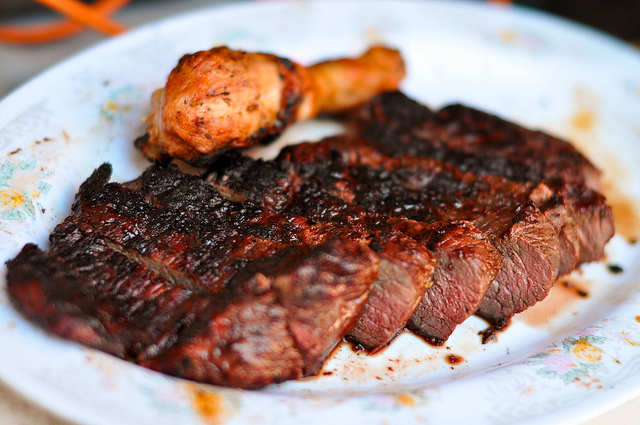Cooking May Have Driven Human Evolution
Why have humans and our ancestors been cooking for all this time? A first-of-its-kind study suggests cooked food gives the body a “pick-me-up”
Unless you’re a fan of steak tartar, cooking meat before you eat it is a matter of course. It’s a culinary custom that human ancestors may have been practicing for millions of years. But is there a reason behind why we’ve been doing it all this time? It could be that prepared animal proteins can provide a body with a “pick-me-up.” In a first-of-its-kind study, Harvard researchers investigated the energy a body gains from consuming cooked meat.
In the study, two groups of mice were given a series of diets of sweet potatoes or beef, served either raw and whole, raw and mashed, cooked and whole, or cooked and mashed. While activity levels—measured by time spent on an exercise wheel—didn’t vary across the different diets, the mice required less cooked food to maintain those activity levels and those on cooked food diets maintained a higher body mass. Mice also exhibited a preference for cooked foods, suggesting that the test subjects themselves were noting a benefit from this particular diet.
Meat and tubers have been food sources for humans for at least 2.5 million years, although without the ability to control fire, food processing consisted of mashing or pounding at the most. But about 1.9 million years ago, human bodies began developing physical traits for long-distance running, and brain and overall body size grew larger—all of which are adaptations that require more energy to support. While earlier theories suggest that the incorporation of meat into the diet was responsible for these changes, this study suggests that cooking the meat allowed our ancestors to gain more energy from their foods, facilitating biological changes. In modern humans, the study notes, raw foodists can experience chronic energy deficiency as well as issues with fertility, and the authors suggests that cooking is necessary for normal biological functions.
weight of their weapon and ammunition. Typical protective gear worn by most American forces, says Body Armor News, “consists of a vest with a series of inserts that protect most of the upper body from armor-piercing rounds.”
Waist gunner wearing helmet and flak suit in action on a heavy bomber, circa 1944. Courtesy Metropolitan Museum of Art.
That got us wondering about the flak jackets worn by World War II bomber crews to protect them from airborne shrapnel. Turns out, their protective gear was designed by the Air Force in collaboration with—wait for it—medieval armor specialists at New York’s Metropolitan Museum of Art. Who knew?
Global Security notes that then-Colonel Malcolm Grow, the surgeon for the Eighth Air Force, tallied the wounds received by his units, and determined that 70 percent were caused by low-velocity flak. He decided that light armor would offer the gunners adequate protection.
According to a 1945 article from The Metropolitan Museum of Art Bulletin (“Helmets and Body Armor in Modern Warfare” by Stephen V. Grancsay), the Air Force consulted the museum’s armor workshop. “The design of Armor Vest M6, which is the latest standardized flyer’s armor, is based on one of the Museum’s brigandines dating from about 1400.” And that’s not all: “The suits of armor in the exhibition halls are constantly studied for suggestions,” wrote Grancsay, “and no type which seems to hold the slightest promise of adaptation is overlooked. Heavy armor for the military sport of jousting, lighter battle armor, shirts of mail, scale armor, and the quilted jackets of renaissance days have all been carefully examined from a new viewpoint.”
